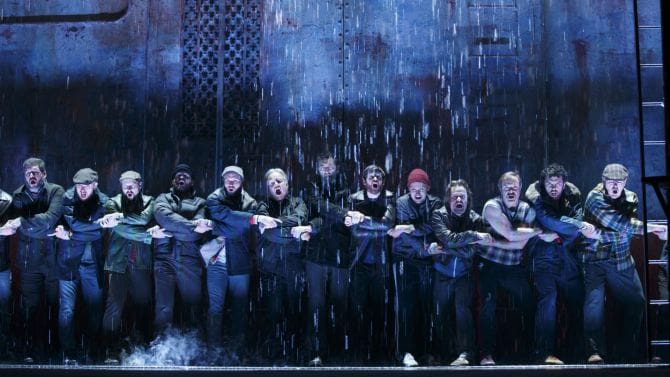After years of development and some very high-profile public try-outs (including a Prime Time showcase on the Tony Awards and a PBS special in February), Sting’s new musical The Last Ship has sailed onto the Great White Way. The wait was worth it. Sting’s lyrics are vivid and compelling and his melodies are rich and powerful – each musical number is a complete tale performed by a refreshing ensemble of actors who pour their passion into this play. Undoubtedly, this work of art is a work of heart.
Inspired by Sting’s childhood growing up in the blue-collar neighborhoods of the English ship building industry, The Last Ship is the story of Gideon Fletcher (aptly portrayed by Michael Esper), a young, wayward soul who refuses to follow his father’s footsteps into the shipping industry and hops on the first vessel leaving England. After years of traveling around the world, Gideon returns home upon the death of his father to a town that has declined economically with the demise of the shipping industry. As Gideon struggles with his father’s death, the town battles the official close of the shipyard and the demise of the jobs that the men and women of Wallsend have expertly held for generations. As a final send-off, and with the assistance of the local priest, Gideon and the people of Wallsend rally together to build one last ship.
The book by Brian Yorkey (Next to Normal, If/Then) and John Logan (Red) incorporates many discernible themes including the prodigal son’s return, the struggle between the workingman and the corporate machine (David vs. Goliath, if you wish to stick with the religious allegories), the search for redemption, and the struggle against change. That said, the book also has noticeable weaknesses. Principally, the plot lacks a string foundation. For example, the plot centers around a new ship building project that requires the townspeople to trespass into the old shipyard for a prolonged period of time. Also, the audience must accept that a small town priest has access to the kind of money required to build a modern ship. Moreover, the plot also lacks a solid ending. It is unclear what the shipbuilders intend to do with the ship once it is finished. Sail it away? Sell it? This is one play where emotional and artistic value is engrained entirely in the personal journeys of the characters and not in the result of their actions, and, as someone who appreciates allegorical story-telling, the plot holes did not prove insurmountable for my enjoyment of the play.
Ultimately, the strength in this tale is also its heart and soul – the people of Wallsend. I cannot think of a better ensemble of actors to bring those people to life than those who comprise the cast of The Last Ship. Michael Esper is a cryptically enticing leading man with a rugged appearance and a powerful voice, and his scrappy, bad-boy Gideon is believable as both a totally screw-up and a leader (a difficult task to pull off). Rachel Tucker plays Gideon’s formidable former love interest Meg Dawson – a tough as nails and resilient woman – and she holds her own in a male-dominated cast. British actor Jimmy Nail absolutely embodies the hardened shipyard foreman Jackie White, who has been beaten down by years of hard work, from his sonorous voice to his sturdy appearance. His was a role perfectly cast. Other noteworthy performances include those of Fred Applegate as Father James O’Brien, the saucy town priest with a heart of gold (and usually a pint of beer) who elicits many laughs from the audience, and Collin Kelly-Sordelet, one of a handful of fresh-faced Julliard grads making their Broadway debuts this year. Kelly-Sordelet’s voice and acting skill is only outshined by the gymnastic feats that he performs throughout the show. He has a lot of energy and spirit. The rest of the ensemble fits right into the Wallsend world that director Joe Mantello (Wicked, Casa Valentina) and his creative team have crafted, and they personify the resilient heart of the shipbuilding community.
Remarkably, there is less technical magic in The Last Ship than one would expect. Mantello stages the opening number beautifully – highlighting the dangers of the shipbuilding industry while capturing the slow demise of the Fletcher family, leading to Gideon’s abandonment of his father and community. Christopher Akerlind’s lighting design is gorgeous and subtle, befitting the tone of the piece, and, aside from a few eye-catching moments when fiery sparks fly from welding equipment, the stage design is simple and dark. The climax of the show is the departure of the newly built ship, and I waited with bated breath to see how they would pull that feat off on stage. Broadway directors have made a magic carpet soar through the air, have had Spiderman leap through audiences, and have lifted a helicopter off a stage, so surely Mantello and set designer David Zinn could come up with some dazzling way to depict the maiden voyage of a ship. To my great disappointment, the final sequence is uninspired. Thankfully, Steve Hoggett’s choreography is befitting of the mood and fierce passion that the people of Wallsend have for their way of life – lots of stomping, clapping, and bold, yet simple movements (with the exception of those performed by Kelly-Sordelet who spends half the show swing, climbing, and flying around the set).
After Bono and The Edge failed miserably in their quest to bring U2’s pop rock sound to Broadway, I thought perhaps that other popular musicians would be too concerned about their reputations to try and conquer a Broadway stage. Perhaps I was being narrow-minded. Perhaps it simply takes the right musician with the right motivation to forge a musical tale worth seeing. Sting has done just that with The Last Ship, which is certainly worth seeing. I can only hope that a cast album is soon to follow.

